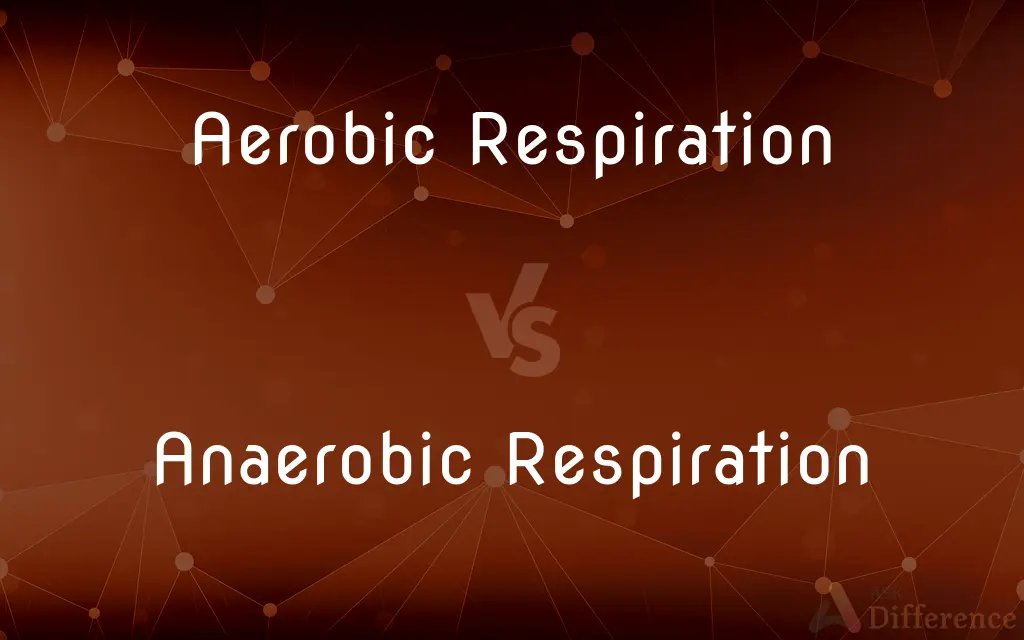Aerobic Respiration vs. Anaerobic Respiration — What's the Difference?
By Tayyaba Rehman — Published on January 3, 2024
Aerobic respiration requires oxygen to produce energy, while anaerobic respiration occurs without oxygen, yielding less energy.

Difference Between Aerobic Respiration and Anaerobic Respiration
Table of Contents
ADVERTISEMENT
Key Differences
Aerobic respiration and anaerobic respiration are two distinct metabolic processes used by cells to produce energy. Aerobic respiration occurs in the presence of oxygen and involves a series of reactions that convert glucose into carbon dioxide, water, and a significant amount of ATP (energy). This process is highly efficient and is the primary method of energy production in most animals, including humans.
In contrast, anaerobic respiration occurs in the absence of oxygen. It is less efficient than aerobic respiration and results in the production of less ATP. Instead of the complete breakdown of glucose to carbon dioxide and water, anaerobic respiration leads to the production of lactic acid in animals or ethanol and carbon dioxide in yeast and some bacteria. This process is crucial for organisms that live in oxygen-poor environments or for muscles during intense exercise when oxygen supply is limited.
Aerobic respiration takes place in the mitochondria of cells, where oxygen is used to fully oxidize glucose, yielding a high amount of energy. Anaerobic respiration, on the other hand, mainly occurs in the cytoplasm and does not involve the mitochondria.
The end products of aerobic respiration are completely oxidized and include carbon dioxide and water, which are non-toxic. In anaerobic respiration, the end products like lactic acid or ethanol can be toxic and need to be removed or further metabolized.
In summary, aerobic respiration is a highly efficient, oxygen-dependent process for energy production, while anaerobic respiration is an alternative, less efficient pathway used when oxygen is scarce or absent.
ADVERTISEMENT
Comparison Chart
Oxygen Requirement
Requires oxygen
Does not require oxygen
Energy Yield
Produces a high amount of ATP
Produces less ATP
Location in Cell
Occurs in mitochondria
Occurs in the cytoplasm
End Products
Carbon dioxide and water
Lactic acid, ethanol, and carbon dioxide
Efficiency
Highly efficient
Less efficient
Compare with Definitions
Aerobic Respiration
It involves the complete oxidation of glucose.
Glucose is fully broken down in aerobic respiration.
Anaerobic Respiration
Anaerobic respiration generates energy without oxygen.
Cells resort to anaerobic respiration in the absence of oxygen.
Aerobic Respiration
Occurs in the mitochondria of eukaryotic cells.
The mitochondria are the site of aerobic respiration.
Anaerobic Respiration
Offers lower energy yield compared to aerobic respiration.
Anaerobic respiration provides less ATP per glucose molecule.
Aerobic Respiration
Provides high energy yield per glucose molecule.
Each glucose molecule yields a high amount of ATP in aerobic respiration.
Anaerobic Respiration
Mainly occurs in the cytoplasm of cells.
Anaerobic respiration takes place in the cell's cytoplasm.
Aerobic Respiration
Produces carbon dioxide and water as byproducts.
Aerobic respiration releases carbon dioxide and water.
Anaerobic Respiration
It leads to the partial breakdown of glucose.
Glucose is partially oxidized in anaerobic respiration.
Aerobic Respiration
Aerobic respiration is the process of producing energy with oxygen.
During aerobic respiration, cells efficiently produce ATP.
Anaerobic Respiration
Produces lactic acid or ethanol as byproducts.
Lactic acid is a byproduct of anaerobic respiration in muscles.
Common Curiosities
Where does aerobic respiration occur?
In the mitochondria of cells.
Why is aerobic respiration more efficient?
Because it fully oxidizes glucose, yielding more ATP.
What is aerobic respiration?
It's an oxygen-dependent process for energy production.
What is anaerobic respiration?
It's an energy-producing process that occurs without oxygen.
What happens to the energy yield in anaerobic conditions?
It decreases compared to aerobic conditions.
Are the end products of aerobic respiration toxic?
No, they are water and carbon dioxide, which are non-toxic.
Can anaerobic respiration happen in humans?
Yes, particularly in muscles during intense exercise.
Can aerobic respiration occur in bacteria?
Yes, in aerobic bacteria that require oxygen.
Is oxygen used in anaerobic respiration?
No, it occurs in the absence of oxygen.
What are the byproducts of anaerobic respiration?
Lactic acid in animals, and ethanol and CO2 in yeast.
Why do muscles undergo anaerobic respiration?
Due to the temporary lack of sufficient oxygen during intense activity.
Can both types of respiration occur in one organism?
Yes, many organisms can switch between both depending on oxygen availability.
What role does aerobic respiration play in the environment?
It's crucial for the carbon cycle and energy flow in ecosystems.
Is ATP produced in anaerobic respiration?
Yes, but in smaller amounts compared to aerobic respiration.
What's a real-life example of anaerobic respiration?
The production of yogurt and cheese involves anaerobic respiration by bacteria.
Share Your Discovery

Previous Comparison
Symmetric Multiprocessing vs. Asymmetric Multiprocessing
Next Comparison
Homogeneous Reactions vs. Heterogeneous ReactionsAuthor Spotlight
Written by
Tayyaba RehmanTayyaba Rehman is a distinguished writer, currently serving as a primary contributor to askdifference.com. As a researcher in semantics and etymology, Tayyaba's passion for the complexity of languages and their distinctions has found a perfect home on the platform. Tayyaba delves into the intricacies of language, distinguishing between commonly confused words and phrases, thereby providing clarity for readers worldwide.














































